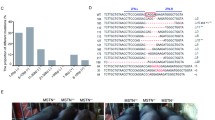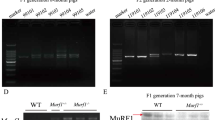Abstract
Objectives
To explore the effects of heterozygous myostatin-knockout (MSNT+/−) on muscle characteristics, specifically fiber-type distribution and expression of myosin heavy chain isoforms in pigs.
Results
The fiber cross-sectional area of the semitendinosus and semimembranosus muscles were much larger in MSTN+/− pigs at birth than in wild-type (WT) pigs. MSTN+/− pigs had a higher proportion of fast-type fibers and lower succinate dehydrogenase activity in muscles than WT pigs. The myosin heavy chain IIB mRNA level in both two muscles was ~ threefold higher in MSTN+/− pigs compared with WT pigs.
Conclusion
MSTN+/− pigs exhibit a disproportionate increase in muscle mass and can have a higher body weight due to fiber hypertrophy, a change in the fiber-type distribution, and alteration of myosin heavy chain isoforms levels, leading to more fast glycolytic fibers.





Similar content being viewed by others
References
Baán JA, Kocsis T, Keller-Pintér A, Müller G, Zádor E, Dux L, Mendler L (2013) The compact mutation of myostatin causes a glycolytic shift in the phenotype of fast skeletal muscles. J Histochem Cytochem 61:889–900
Costill DL, Daniels J, Evans W, Fink W, Krahenbuhl G (1976) Skeletal muscle enzymes and fiber composition in male and female track athletes. J Appl Physiol 40:149–154
Jiao J, Yuan T, Zhou Y, **e W, Zhao Y, Zhao J, Ouyang H, Pang D (2011) Analysis of myostatin and its related factors in various porcine tissues. J Anim Sci 89:3099–3106
Kang JD, Kim SJ, Zhu HY, ** L, Guo Q, Li XC, Zhang YC, **ng XX, Xuan MF, Zhang GL, Luo QR, Kim YS, Cui CD, Li WX, Cui ZY, Kim JS, Yin XJ (2017) Generation of cloned adult muscular pigs with myostatin gene mutation by genetic engineering. RSC Adv 7:12541–12549
Katsumata M, Yamaguchi T, Ishida A, Ashihara A (2016) Changes in muscle fiber type and expression of mRNA of myosin heavy chain isoforms in porcine muscle during pre- and postnatal development. Anim Sci J 88:364–371
Kim NK, Lim JH, Song MJ, Kim OH, Park BY, Kim MJ, Hwang IH, Lee CS (2008) Comparisons of longissimus, muscle metabolic enzymes and muscle fiber types in Korean and western pig breeds. Meat Sci 78(4):455
Kocsis T, Baán J, Müller G, Mendler L, Dux L, Keller-Pintér A (2014) Skeletal muscle cellularity and glycogen distribution in the hypermuscular compact mice. Eur J Histochem 58:2353
Lefaucheur L (1990) Changes in muscle fiber population and musde enzyme activities in the primiparous sow. Reprod Nutr Dev 30:523–531
Lefaucheur L, Hoffman RK, Gerrard DE, Okamura CS, Rubinstein N, Kelly A (1998) Evidence for three adult fast myosin heavy chain isoforms in type II skeletal muscle fibers in pigs. J Anim Sci 78:1584–1593
Martyn JK, Bass JJ, Oldham JM (2004) Skeletal muscle development in normal and double-muscled cattle. Anat Rec A Discov Mol Cell Evol Biol 281:1363–1371
McPherron AC, Lawler AM, Lee SJ (1997) Regulation of skeletal muscle mass in mice by a new TGF-beta superfamily member. Nature 387:83–90
Meurens F, Summerfield A, Nauwynck H, Saif L, Gerdts V (2012) The pig: a model for human infectious diseases. Trend Microbiol 20(1):50–57
Rehfeldt C, Ott G, Gerrard DE, Varga L, Schlote W, Williams JL, Renne U, Bünger L (2005) Effects of the compact mutant myostatin allele Mstn (Cmpt-dl1Abc) introgressed into a high growth mouse line on skeletal muscle cellularity. J Muscle Res Cell Motil 26:103–112
Ribarič S, Čebašek V (2013) Simultaneous visualization of myosin heavy chain isoforms in single muscle sections. Cells Tissues Organs 197:312–321
Shen LY, Luo J, Lei HG, Jiang YZ, Bai L, Li MZ, Tang GQ, Li XW, Zhang SH, Zhu L (2014) Effects of muscle fiber type on glycolytic potential and meat quality traits in different Tibetan pig muscles and their association with glycolysis-related gene expression. Genet Mol Res 14:14366–14378
Wang M, Yu H, Kim YS, Bidwell CA, Kuang S (2012) Myostatin facilitates slow and inhibits fast myosin heavy chain expression during myogenic differentiation. Biochem Biophys Res Commun 426:83–88
Yin XJ, Tani T, Yonemura I, Kawakami M, Miyamoto K, Hasegawa R, Kato Y, Tsunoda Y (2002) Production of cloned pigs from adult somatic cells by chemically assisted removal of maternal chromosomes. Biol Reprod 67:442–446
Acknowledgements
This work was supported by the Science and Technology Development Projects of Jilin Province of China (Grant Number: 20160520057JH) and ToolGen, Inc. We thank the Hanji and Longxing pig farms for providing surrogate pig recipients and their enthusiasm and support for this research.
Supplementary information
Supplementary Table 1—List of primers used for quantitative RT-PCR.
Author information
Authors and Affiliations
Corresponding author
Electronic supplementary material
Below is the link to the electronic supplementary material.
Rights and permissions
About this article
Cite this article
**ng, XX., Xuan, MF., **, L. et al. Fiber-type distribution and expression of myosin heavy chain isoforms in newborn heterozygous myostatin-knockout pigs. Biotechnol Lett 39, 1811–1819 (2017). https://doi.org/10.1007/s10529-017-2422-2
Received:
Accepted:
Published:
Issue Date:
DOI: https://doi.org/10.1007/s10529-017-2422-2




